► Mercedes G-Class goes all electric
► One electric motor per wheel
► The fastest and most capable G ever?
After much teasing, the all-electric G-Class is finally here. Despite being virtually identical to the ICE G at first glance, manager of eDrive Manuel Urstoeger reveals some very clever engineering bolted to the traditional underpinnings. That’s right, it retains a ladder frame chassis, a rigid (if not live) rear axle and the independent front suspension that was ushered in with the Mk2 G-Class.
What makes it go?
Not only do you get four motors, but each one is also connected to a two-speed gearbox to provide a low-range mode that mimics the ICE G-Class. This allows smaller, lighter motors that are easier to cool, too. Combined they produce 579bhp and 859Ib ft of torque, enough to ping 3.1 boxy tonnes from 0-62mph in less than five seconds.
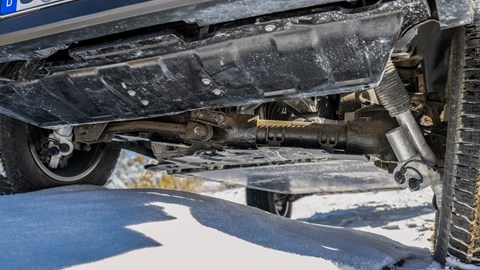
If, like me, you were wondering how Mercedes had integrated a pair of electric motors into a live rear axle, the simple answer is that they haven’t. Instead, there’s a De Dion tube that allows the heavy motors and gearboxes to be mounted to the chassis. A pair of driveshafts exit the drive unit and connect to wheel hubs that instead of being mounted on suspension arms, are linked to each other to form a ridged axle. This retains all the lovely suspension travel G-Class owners have come to expect whilst adding plenty more they’ll come to love.
A 116kWh battery pack is slung between the chassis rails to lower the centre of gravity and ensure no interior or boot space is lost to electricity. The pack is protected by a composite guard that’s entirely flat and weighs a third of what a steel plate would. That helps aerodynamics and doubles as a skidplate for particularly rocky terrain. The pack’s cells are shared with the updated EQS, although the G 580 has double the drag at .44 against the slinkier saloon’s .22.
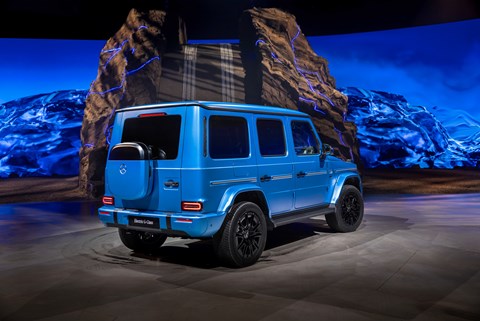
Tweaked aero
That might sound terrible, but bear in mind the pre-facelift G-Class had a drag co-efficiency of .53. Improving that figure whilst retaining a very un-aero shape meant reprofiling the A-pillars, adding a small spoiler above the windscreen and some air curtains for the rear arches.
The ICE G gets these changes, but the EV also gains a bigger bonnet bulge to flick more air over the windscreen rather than into it, a front-drive disconnect and that largely flat underside. That helps provide a predicted WLTP range of around 300 miles and supposedly quieter cruising manners than previous Gs.
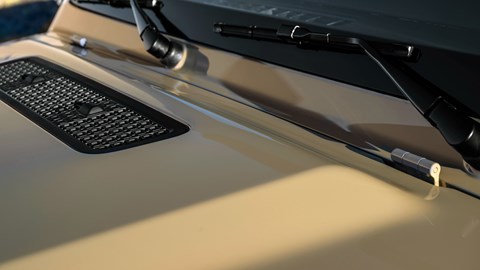
However, it’s off the road that the G-Class should excel, so perhaps more importantly, you can ascend and descend the Schöckl mountain pass, the G-Class’s traditional proving ground, 14 times on a single charge. Unlike the ICE G, you don’t get traditional diff locks as there isn’t a differential. Instead, torque vectoring creates a ‘virtual’ diff lock to allow all four wheels to rotate at the same speed.
Clever off-road tech
Torque vectoring allows you to do other clever stuff, too. That includes the ‘G-Turn’, where you can perform a full 360 or 720-degree turn on the spot by driving the motors on the left-hand side the opposite direction to the rights. It’s great for drawing attention to yourself, and it should make navigating tight off-road situations easier, too.
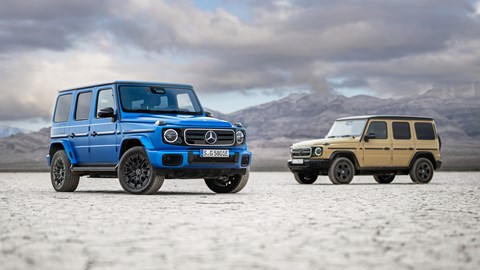
If the full G-Turn is a bit extreme, there’s always G-Steering. This stops the inside rear wheel and fiddles with the torque of the others to provide a significantly smaller turning circle without the weight and complexity of a four-wheel steer system. Like the G-Turn, Mercedes doesn’t recommend you try this somewhere paved like the middle of Chelsea. Instead, it’s perfect for avoid three-point turns halfway up a mountain.
To make driving across your estate even easier, there’s also an intelligent off-road crawler function. Effectively off-road cruise control, it’ll maintain your speed regardless of angle or surface with far finer control than similar systems in ICE off-roaders.
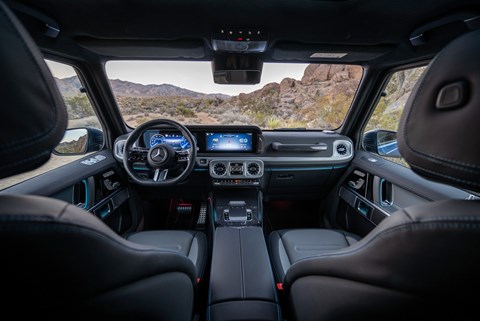
Weight and charging
So, what about the thorny subject of weight? With such a big battery pack in an already heavy platform the 3085kg kerbweight shouldn’t be too much of a surprise. This weight doesn’t prevent it from being able to climb a 45-degree angle with a grippy enough surface and have a 35-degree maximum lean angle. If you’re still worried about automotive bloat, opt for the EQ-only squircle storage box on the back instead of a full-sized spare to save 40kg and have somewhere handy for your charging cables.
And those that worry about water and electric mixing shouldn’t panic – Mercedes developed a new test rig to make sure the battery could survive being dunked under water, twisted, and survive in both hot and cold conditions. The maximum fording depth is even higher than the ICE model at 850mm, although this is limited by the height of the charging port. Speaking of, the G 580 will accept a maximum AC rate of 11kW or 200kW DC – good for 10-80% in 32 minutes.